Over the centuries, silk thread has been particularly favored for fine embroidery for a number of reasons, but the dominant reason is this: it is a naturally beautiful thread. No other fiber compares to silk for its natural, age-defying beauty.
Most cotton embroidery threads have a sheen to them. But under the glaring eye of Time, that sheen – which is chemically produced through a process called mercerization – fades. Not so with silk!
The natural sheen of silk is especially beautiful because of the way light plays off it. I’ll show you what I mean, while we chat about a project I’m working on.
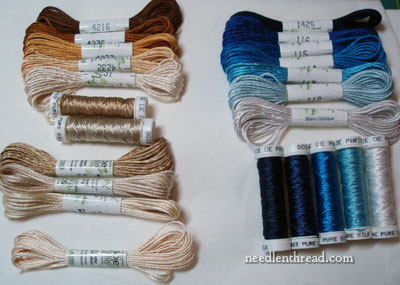
These are the silk embroidery threads I’ve half-way chosen for this project. Why half-way chosen? Well, I’m not certain I’ll use all of them. But whatever silk threads I do use, I’ll be choosing from this line-up.
On the right side of the photo are the blues. The skeined threads are Soie d’Alger, a stranded spun silk. Spun silk is made from the “leftovers” of the silk cocoons (or from broken cocoons), after the long, fine filaments of silk have been pulled from them. The fibers in spun silk are … well… spun, much like most other fibers are spun into thread. Spun silk has a soft luster to it. It is not the same high sheen that is found on filament silk made from the long filaments pulled from whole silk cocoons, but it is still luster. It still shines softly.
The thread on the spools is Soie de Paris, which is a softly twisted filament silk. If you look at the spools in the photo above, you can see the difference in the sheen – the thread on the spools really shines!
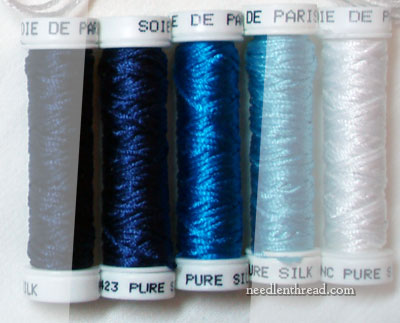
In the project I’m working on, I’m using the two blues highlighted above, predominantly. In fact, I’m not even sure I will use the other blues in either photo. Although the project has been underway for a while, I’m still feeling my way through it!
I can’t reveal the whole project just yet, because it’s actually for publication in a book (not by me). When the book gets closer to publication (and assuming the project ends up in it – who knows? The publishers may think again when they see the finished work!), you’ll be able to see more of it. But in the meantime, anything I share with you has to be in bits. This, unfortunately, is the conundrum I’m facing: when writing a needlework blog, how do I maintain articles for my own website, while writing things for other people, too? It’s not easy!
But while stitching these types of “side projects,” I find myself thinking of topics I want to share with you, that the projects aptly illustrate. And hence, here we are at today’s discussion on silk.
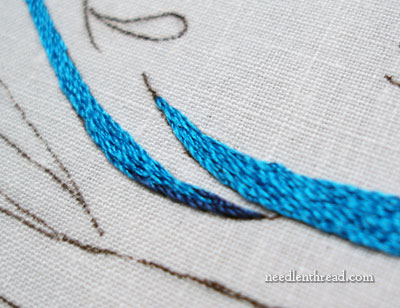
It isn’t really the silk thread in skeins and on spools that I want to show you. It’s the silk thread in action!
I’m filling these swashes you see in the photo above with the Soie de Paris, using long and short stitch. I’ve only used the medium and the dark blue – the dark blue right at the tip of the swash, and the rest of the swash is that brilliant, bright blue. It is blue-blue. It’s a difficult blue to explain. Perhaps there is an artistic, technical term for it, but if so, I don’t know it. It’s not sky blue. It’s not green-blue. It could almost lean towards what people might call an “electric” blue – but it isn’t. It’s just blue. True blue. And it is a beautiful color of blue!
But, it all depends on how the light hits the silk! In the photo above, the light is coming straight on to the blue, and the camera is looking straight at it.
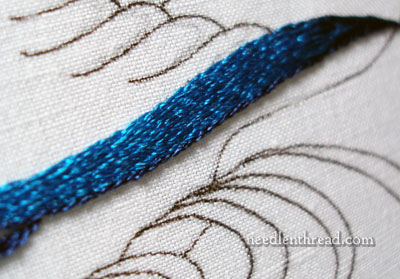
And in this photo above, the camera is off to the left side.
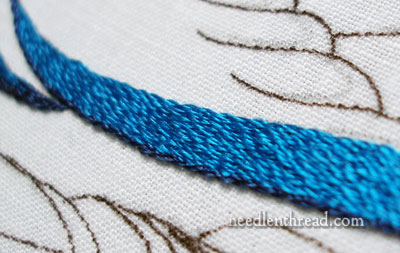
Here, the camera has moved to the right side.
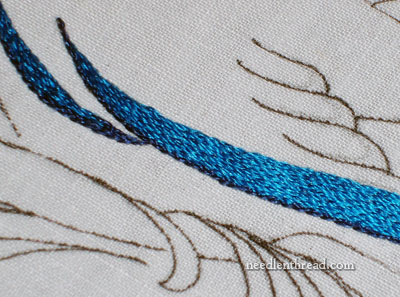
And here, the light source has changed slightly – it’s later in the evening, so the room is not as bright. The camera is farther away from the embroidery, and the flash is on.
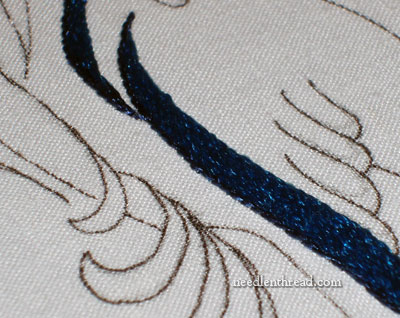
Here, the distance from the embroidery is the same as in the previous photo (the cropping changes the size of the photo), but the angle of the embroidery frame is slightly different. The flash is still on.
The camera doesn’t see things exactly as the naked eye sees them (sometimes, it sees them better!), but in general, this is exactly what happens when I move the embroidery frame around and tilt it at different angles – the changing angle of light on the thread changes the look of the thread. Other fibers do this, but they don’t do it to the same extent that silk does!
If you have the opportunity to play with some real silk thread, see what the light does to it while you stitch! You’ll start to notice that stitch direction, stitch type, and thread type can work together to produce different visual effects, thanks to the way light gets involved with them.
What about you? Are you a silk thread fan? If so, what’s your favorite silk for embroidery? What do you like best about using silk? If you’re new to embroidery and you haven’t ventured into silk yet, do you have any questions about using silk that the rest of us might be able to help you with? Feel free to discuss anything silk-thread-related, or to pose any questions or make suggestions, using the comment form below!
Tomorrow, a give-away! For all you Morris fans out there, all quilt lovers, all textile enthusiasts, and embroiderers, I’ll be giving away two beautiful William Morris Appliqué calendars for 2013! They’re really lovely! So look out for that.
See you tomorrow!







Mary, don’t do this to me. Please. Don’t.
Sorry, Natasha!!!
Hi
I just wanted to let you know what a massive change in my life your emails have made.
For years I have often visited ‘Ancient Monuments’ and enjoyed both the houses and the gardens.
I came to your blog from another and cannot remember why but I just love your posts, I wish I had found you a long time ago!!!
Anyway wanted I wanted to tell you is something that happened within this last week. I visited Inveraray Castle and started my visit as usual – oh1 yes! vry nice etc. THEN I realised what I was looking at …….. 16th Century tapestry! I looked closely at the seating, the curtains, the wall hangings ……. I was in heaven!!! Your teaching about the old sampler band that you have detailed over the last few weeks came back to me!!!! I lookes so closely at the stitching, so called repairs (oh! how they hurt when I thought of the time and effort you had taken to explain to us how your piece of work had been constructed) It is a whole new world opening up for me and I cannot thank you enough.
I also visited Stirling Castle (I was on holiday in Scotland) and was horrified to see that the wall hangings were modern. My friend thought it very amusing at my change of attitude towards what was just pieces of material to her!!!
Thank you so very, very much for bringing all this ‘extra’ to life for me.
Thank you very much.
Christine
Hello, Christine! Well – you have been traveling! It sounds like you had a lovely journey and saw some beautiful things! And I’m glad you enjoy Needle ‘n Thread! That just made my day! 🙂 ~MC
Christine, don’t despair about the tapestries in Stirling Castle. I’ve been watching them being woven for the last decade. (Stirling is my “local” castle, as it were.) They are fabulous. If you live in the UK, make an effort to go back and then go down to the battery and into the weaving sheds. There you’ll see the weavers at work and might even be in time for the 1pm talk. More here: http://www.stirlingcastle.gov.uk/home/experience/highlights/tapestries.htm
Thanks Mary, for all your excellent posts and very, very helpful videos. I’m currently working on a panel of the Great Tapestry of Scotland, and I am in your debt!
G’day there Mary,
“True blue”…smacks of Oz. “True Blue…cockatoo…is it standing by your mate…Vegimite…true blue” – John Williamson. What, not heard him or of him?! Fair dinkum!
And it’s mulberry season here now re commenting on something to do with silk!
I do have a few skeins and spools of silk thread though, which I’ve bought on special at different times because I love the look of them. I’m guilty of never having used them though.
I hereby, do solemnly promise, to look at them more often from this day forward. There!
Thank you for this post. Interesting about the makings of silk thread and THAT project is intriguing.
Cheers, True Blue Kath.
Heh heh heh. Yes, I know who John Williamson is. It’s kind of like knowing who Hank Williams is…!
Actually. I’m more of a Rolf Harris fan, myself! It’s the kid in me, I guess.
Try the silk, Kath, try the silk!
Yeah, don’t mind Rolf myself. We all had our own wobble boards as kids. They made the house cows run! Like his paintings too, but Hank who? Just trickin’. Was brought up on his 75rpm bakelite records. I’m not really THAT old. The records were old then.
Ah, yes, the silk. Thank you for the genuine encouragement.
I’m not new to embroidery – but I’m still far from my potential. You & your site have sparked my desire in embroidery again – I love the depth of your explorations and your style is so very intriguing.
The silk is gorgeous & I would love to experience working with it. Do you have any resources that are frugal for those on a very limited budget?
Thank you for all you share!
Blessings-
tabithagrace
Hi, Tabitha Grace – I suggest budgeting for the good stuff. I look at it this way: inferior products will not give you superior results. So if you’re going to use silk, use the good stuff, and budget accordingly. Using an inferior silk thread (one that is slubby, that breaks easy, that tangles and pills, etc.) will only make your experience with silk more frustrating and will put you off the stuff. If you’re not confident of your skills yet and ready to invest in more expensive threads, then keep using good cotton flosses and practicing, until you can justify the investment in silk threads. At some point, if you continue to learn and practice and enjoy embroidery, you will hit an “ah-ha!” moment, when a certain project (maybe a kit or a design you see) will really appeal to you, and you’ll just have to embroider it, and at that point, you’ll be more comfortable making the investment in good silks for it. ~MC
I’m a long time fan of your site. I have never tried silk threads before. Does it fray easy?
Do have to use a certain type of needle or material? Thank you for any info you can give me.
Hi, Meleeisa – It depends on the silk you’re using. Filament silks do not tend to fray at all. Silk is an extremely strong fiber, so it is not prone to falling apart. However, spun silk is a little different, because of its construction. With spun silk (like Soie d’Alger) it’s always best to work with short lengths of thread (about 16-18″). No, no special needle for silk – just embroidery needles (crewel needles) – whatever needles are normally used for surface embroidery. For fabric, if you’re going to use silk, you should invest in good ground fabric, like linen or silk.
~MC
I don’t have any silk thread, nor have I used it on any project, but I can tell you after reading this post – I really want to!!! 🙂 Can you tell us the best place to purchase it? I imagine it’s not cheap, and I’ll have to save up my pennies (well, quarters now, with inflation and all) in order to buy some. But I can do that, and whatever it is you’re making – it’s beautiful! Karen
Hi, Karen – Hedgehog Handworks (www.hedgehoghandworks.com) has some of the best prices online. They carry the whole range of Au Ver a Soie silks. You can also buy color packets, just to try different silks. You might check those out. I’d love to see a multi-colored “sample” packet of a variety of silk threads available, but there isn’t one at this time. Kits that use good silk are also a great way to go!! ~MC
Reminds me of hummingbirds, how the gorget at their throats shifts colors depending on the angle. Amazing beauty.
On another embroidery forum yesterday, someone wrote in, said they had discovered a box of silk embroidery threads from a relative. Said she would never use them, many still have the original tags on them, wanted to know if there was a place that restores old pieces of needlework that could use them. I think there are thousands of people that would love to run their fingers through the silk but I think her idea is excellent. Still, I wish I could see them.
Ahhhhhhh….. old silk threads….. I love them! I’d love to find a whole abandoned workroom full of them! 🙂
That is extremely nice thread. We use rayon, but this almost has a sparkle or a shine to it.
I absolutely love stitching with silk. I’ve used NWS, the same silks as you are using,Mary. But I think my favorite of all…so far is Glorianna silks. They feel so smooth when stitching…they “glide”. Someone said they use Rayon thread. My. Experience with rayon…it is slippery, it frays…but it is pretty when its laid down! Just not worth the trouble.
Silk IS more expensive but worth every penny (quarter) LOL.
Hmmm… not quite sure I’ve heard of NWS? Maybe it’s called something else? Yes, I’m not a huge fan of stitching with rayon, either! 🙂
I love the shine of silk, I would like to have all those threads. Sadly I dont find it here.
I’m new to working with silk. I haven’t been able to find any silk embroidery thread here in sparks nv. I’m making a wool crazy bedrunner for a present and am trying to do variour stiches. Love your e-mails. they keep me trying new things. thanks. neena
Hi, Neena – I can’t find threads close by where I live, either (out in the boonies in Kansas). I have to order online! I’m glad you enjoy the e-mails! ~MC
That was a very interesting article. I have always used DMC threads and would really like to see what the difference looks like when compared with the silk thread in the same color. Could you show that in one of your articles? Thank you.
That’s a good idea, Jean! I’ll see what I can come up with!
Since I started embroidering (and bobbin lace) with silk I can barely stand to use anything else. The results are incomparable and the tactile satisfaction of working with the thread unmatched. I’ve used most of the Au Ver A Soie line, but haven’t played with the Soie de Paris yet. You’re evil – now I want some!
Mwahahahahah. That’s me! Scary Mary!!!! >:-)
LOVE the colors. This is a favorite of mine, and I feel silk threads are worth
Every penny. One of my current projects is iin a turquoise and brown
Color ways and I thoroughly enjoy it. I find If I love the colors there is
Extra joy in the stitching.
I am new to silks and am looking for recommendations for use in cross stitch on linen. I cannot get my stitches to lay nicely with DMC. I love the silk colors. Suggestions?
Hi, Vicki – the easiest type of silk to use is stranded, spun silk like Soie d’Alger. It comes in some 600 colors & shades, and it’s a beautiful, beautiful silk. You use it pretty much like you use stranded cotton (DMC floss) – separating the number of strands you need and putting them back together, then threading them into the needle… and stitching away! With silk, I suggest using somewhat smaller lengths than usual. I usually stitch with 16″ – 18″ in the needle. Soie d’Alger has 7 threads per strand as opposed to the 6 in regular cotton floss. You can find Soie d’Alger at Hedgehog Handworks online (www.hedgehoghandworks.com). It is decidedly more expensive than cotton, tis true….
Soie de Paris is also used pretty much the same way, but it’s a filament silk, and it does take some getting used to, if you aren’t used to working with filament silk. But it has a GLORIOUS sheen to it, and is stunningly beautiful. Unfortunately, it doesn’t come in such an extensive range of colors. It’s also a finer thread, so it takes more thread to cover.
~MC
PS – Incidentally, have you tried using a laying tool when you stitch? I have a video here on Needle ‘n Thread to show you how to use one. It helps, if you’re having trouble getting your threads to lie the way you want them to. Also, make sure you’re “stripping” your floss – taking the individual strands out of the whole bunch (one at a time) then putting the number you need back together. This also helps!
Thank you Mary! I’m not sure if my problem is bcse I am left handed or what. I railroad but it does not seem to help…I will review your laying tool video. Also, what is the best way to store silkfloss?
Hi Mary
Have you tried Piper silk threads from the uk, they are fantastic to work with and have a extensive colour range.
Hi, Rosemary – sure have. The black work fish project was all done with different weights of Pipers silks. Their “floss” – like the kind Helen Stevens uses – is a flat filament silk, very fine. I prefer Soie Ovale, because it has a bit more body to it, but Pipers is great for tiny details! MC
After working on large projects for years, I have moved on to the opposite…..small, very small and smallest! I have created a profusion of pincushions, bounteous biscornu and nineteen needle books……all using 30 ct. linen and SILK THREAD. I have loved using Kreinik Silk Bella because of it’s colors….some vivid, some muted but all glorious and rich. I have ordered the fabric and thread from the Nordic Needle and I am always thrilled to get a new color of linen that I’ve never used before. This week in their newsletter they advertised Chocolate Raspberry or was it Raspberry Chocolate? I ordered it on the spot and am sitting by my mailbox in anticipation of its arrival. I would gladly send photos of my work if anyone is interested.
Hi, Karen! I’d love to see your work! Send photos – or you can also post them in the gallery section on the Ask & Share part of the website, if you like! Chocolate Raspberry sounds like a great color!
Mary, I must tell you that I save your posts with their informational and inspirational treasures alike. I am sure you know of a blue, called “Parrish Blue”, after the luminous blue Maxfield Parrish developed and used in his many paintings. Your blue silk reminds me of it, I know it is may be slightly different.
Deb in Idaho
Tempting Tangles Designs
Hi Mary!
I had not thought of the permanently reflective qualities of silk until you pointed this out. I agree it’s better and plan to begin using silk immediately! I am enjoying doing the same thing in the interior of my house using metal (especially gold!) and reflective fabrics – the shine is very attractive!
Thanks for the tip!
Peggy
I have been following up with your e-mails for a long long time. Over fvive years…I think. I have learned a lot from your e-mails
and dont miss a day going through your e-mails
which are ever informative.
To be honest I have never worked with silk threads though am very familiar with rayon and
DMC cottons. I can see how beautiful silk work is from your displays. Would be very interested in learning more about silk work.
Thanks Mary
Dorothy
Hi Mary,
I love to work with silk threads. I’ve used three different ones. Japanese silk is beautiful and expensive, but the one’s I really like are the Piper’s silks and The Silk Mill threads that I have bought on-line from the Silk Mill. I’ve used silk on embroideries I’ve done on priests vestments. Piper’s silks are very fine where the Silk Mill ones are stranded. I love the sheen and the play of light that you get from stitches going in different directions. I do have to be careful though. I have a tendancy to get very dry hands in the autumn and winter, and the dry skin can play havoc with silk. Applying hand cream doesn’t help much, so I use an emery board to ‘file’ the skin on my fingers to make it smooth, and that allows me to stitch for a while.
Hi, Joan, I use flat silk all the time. For your hands have you ever tried an exfoliant like for your face? Also, Mary Kay makes a hand exfoliant. I usually use one or the other once a week.
Hi Anneg,
It’s the time of the year for me so nothing works at all. As soon as the weather just starts to go cold I get all sorts of problems from dry cracked hands to intense itching all over. Spring comes and it stops!!!!! Thank you any way for your kind suggestions.
Mary,
The term you may be searching for is “sacre bleu!” sacred blue. When blue pigments first became available, they could only be used to pain the virgin Mary, or so I’ve heard . . .
The name of the blue you are looking for is cyan blue; it is your primary blue from which many colours are made. Your blue silk doesn’t look like a pure cyan but rather a cyan with a tiny bit of red added.
I love using silk! I use it in embroidery, bobbin lace and needle lace. I have found over the years that using silk helps to work harder at stitching. It is very forgiving, and “moves” to where you need it. However, you need to control it. The slickness helps you to slide the stitch to the correct tension or stitch size. I’m currently working on a needle lace piece with some Tire sewing silk…SO MUCH FUN!
Japanese silk is my all-time favorite because of its sheen. However, I like doing early American- or English-style sampers and favor Soie d’Algers for that.
Hi Mary
I’m working on a project that depends on the natural lustre of silk – the georgous sheen of an Australian gum tree. I embroidered many fabrics and threw them all away before making a “silk paper” tree. It’s still a work in progress and the tree is only the base fabric but it has the sheen I want.
I’d like to couch silk thread to highlight the tree’s knots and different colours down the tree and hoped you might be able to advise me as to what type of silk thread to use.
Hi Mary et al,
I’ve used silk buttonhole twist and Trebizond to do crazy quilt stitches on lots of different projects. Thread Heaven can help to minimize tangles. Using shorter thread lengths helps with thread wear. Taking good care of your hands with moisturizers etc at bedtime and whenever you aren’t stitching also helps when handling silk threads. The results are worth it! Thanks as always, Mary for your ongoing passion for needle and thread!
Hi Mary, as always the work and threads you have are beautiful, I look forward to your newsletter every morning while I have my coffee, it sets my mood for the day, thank you. I love the silk but only use it on something special as it is a little expensive, it is lovely to work with especially on long and short. Your project has got the inquisitive side of me going, what are you making, please share like you always do, is it a bird of sorts.
I love using Soie d’Alger silk thread. Last year I completed a thread painting butterfly picture with various greenery and flowers from “Inspirations” magazine. It consisted mainly of DMC but had some Soie d’Alger in it as well. The silk stands out effectively as you suggest from different light angles.
Thanks for this ‘enlightening’ explanation of the difference in spun silk and filament silks.
Those two threads would be absolutely perfect to embroider a Splendid Fairy Wren (Western Australian tiny, dazzling, cheeky bird). Do you need to steam them before you can tame them? The threads I mean!!
LOL… Glad you meant the silk! No, no steaming or taming required…
Oh Mary, you have done it again – here I am, sitting in bed with the laptop and salivating like a mad puppy. I just looove silk, and I just loooove blue, so this is an utterly irresistible combination.
I use silk a lot but I also use cotton a lot – for me, the colour is the more important quality and I will go to enormous lengths to hunt down the right colour.
Talking of colour, I think this is probably pretty close to cobalt blue. The reason for sacre bleu was that early artists had to grind their own pigments and mix them with oil to make paint – a job often done by apprentices in the studio. The only blue pigment available was lapis lazuli which was very expensive, hence its use was constrained to the Virgin’s robes. That also goes to making the painting ‘readable’ by the illiterate masses – when they saw a figure draped in blue they knew it was the Virgin Mary, if the figure was in red, it was Mary Magdalene – the original Scarlet Woman.
Have you tried Mulberry silks from the UK. They are not the most lustrous, but the colours are luscious. The problem is that they seem to be available only in sets so if you want just one or two colours it becomes a very costly exercise.
I just finished using Soie Ovale, a flat silk, in the background of my Agnus Dei project using your project as a guide. It was really fun. I was surprised at how wonderful it was to work with. And the changing of the blue colors through out the day is amazing. Sometimes the sky looks bright and sunny, at other times, dark and full of mystery. I would not have been able to tackle such a project if not for your guidance!
I recently received a few spools of the Soie de Paris, and can hardly wait to try them. That is one wonderful silk! So very pretty! I wish they had all of the regular Soie D’Alger colors in the Soie de Paris…sigh……but then my budget would be sighing too:)
Are the blue colors you are using in the Soie de Paris available, or are those the new colors still in the works for release? I vaguely remember a post about these colors a while back.
Hi, Carrie – isn’t Soie Ovale wonderful?? The colors of Soie de Paris I’m using are not new releases – they are definitely available! If you want the color numbers, drop me a line and I’ll send them to you! MC
Good morning Mary,
I am indeed a silk addict! Maybe we should start a Silk Anonymous group here :)… My favourite silk is pure Chinese Silk from oriental cultures (http://stores.ebay.com/orientalcultures). Apart from being really nice silk, the price is very good too. Especially when you buy in bulk. I will probably make another convert today as I will be teaching silk shading to one of my regular students later today.
For the past month, I was actually over on your side of the pond. And lucky me found a piece of exquisite antique Chinese embroidery in a shop in San Francisco. The price was very (and I mean very!) low due to the background fabric not looking too yummy and no know provenance. However, the embroidery is of a very high standard and features typical Chinese flowers and butterflies. The seller thought that it once was part of a bed hanging. Over the next few months, I will consult with my colleagues at the Studio of the RSN to see if we can clean the piece a bit.
Have a nice day, Jessica
What a wonderful inspiration to make every day filled with ‘nothing that you do not know to be useful and believe to be beautiful’. Could you imagine if we all lived like that!
Hi Mary what is the best way to store silk floss?
Hi, Vicki – Well, it depends. Are you talking about long term storage? Silk floss is pretty resilient, but like any textile / fiber, it can be affected by light, dirt, dust, chemicals, etc. Because I do quite a bit of work with silk, I have an extensive range of silk threads, so I’ve invested a bit in their storage and organization. You might not necessarily take the same route, if you go through your threads more quickly. Anyway, I store mine in flat-file “collector” cabinets by Bisley, which keeps them clean, away from light, dust, etc. However, the cabinets are fairly expensive (you can get them on sale from Container Store once a year for considerably less, though). Another option is to buy acid-free tissue paper and line the boxes you have with it, or wrap your threads in it. This is what I do with “overflow” that doesn’t fit in my cabinets. I know a lot of folks like to be able to see the colors of their threads at a glance, and so they opt for plastic, but I prefer to keep my threads away from light and dust and other elements that could be harmful over time, so go overboard a little bit, especially with threads that I may not use for a long time.
Hope that helps a little! ~MC
This is really useful! I’m making my wedding dress at the moment, and planning to embroider the bodice. I had thought to use Soie d’Alger, but now I’m thinking I might have to get some Soie de Paris as well!
Dear Mary
I love it when you talk thread especially comparisons with different threads. I love, love!!! Soie D’algar and Soie de Paris, I love the feel of these silk threads and I love stitching with these threads and like you I love the sheen and shine of these silks with the changes of light.
Yes they are more expensive than cotton threads but I think they are still affordable and the outcome far surpasses any other thread.
Did I say I love Soie D’algar and Soie de Paris!!!!!!!
Regards Anita Simmance
Hi Mary, it’s me again. Question for you…I’m thinking of returning some DMC I recently purchased for some cross stitching projects and buying the equivalent colors in Soie d’Alger.
I just read that silk fibers should be dry cleaned…some of my cross stitching fabric gets a little dirty over time (I am a serial project starter). What would you recommend in this case before framing a project? I use mostly color-fast hand-dyed linen fabric. Thanks.
I am keen to use these threads in a project I am currently working on.Do they come in yellow/gold colours and where can I purchase them.
Thanking you
Pauline downey
Hi, Pauline – you can buy them from various shops online. Hedgehog Handworks has the best prices, usually, but Needle in a Haystack has images of each spool or skein so you can see the colors… MC
Dear Mary,
Perhaps the term “Peacock Blue” describes the lovely, iridescent color you have chosen. And thank you for letting me sit quietly in the corner and savor the beauty.
what type of sewing stitch was used in this project
I like what the green heron said. About sitting quietly in the corner. But allow me to ooh and aah once in a while, Mary.
What i ABSOLUTELY love about this pattern-the desin, the thread, the colour, the sheen, your work. Its swoon-worthy
Dear Mary, I live in Cape Town, South Africa, and recently came across your website. It is a fantastic site. There is so much to learn from you. I used to embroider many years ago, and seeing your site has inspired me to pick it up again. I adore the look of the silk threads, the only problem is finding companies that’ll post to South Africa, but I am always hopeful! I’ve ordered some Coton a Broder, as I don’t like the way the ordinary DMC threads start to fluff up after washing an item. Can’t wait for it to arrive, that’s if our delightful Post Office doesn’t swipe my package 🙁 . Thank you for all the knowledge you are sharing, it is really appreciated.
All the best, Suzy.
Hello Mary,
I was introduced to silk thread many years ago when I took a class given by Donna at the
Yankee Cross stitch in New Hampshire It was an A to Z sampler. I loved the class and fell in love with the silk thread that we used is some of the projects. It’s lovely the way it glides through your fingers and the sheen is perfect and the way the colours blend is beautiful.My favourite silk thread is soie d’alger I love to go to their website http://www.auverasoie.com/ and look at the lovely colours and I google it into English so I can understand what they are saying. I will never be able to obtain all 620 colours but I have quite a few. A word of warning always make sure you hands are not dry and nails are nice and smooth or the silk thread tends to attach itself to the nails or rough skin.
I was given your wonderful blog site by the owner of the Yankee Cross Stitch. I have really learnt alot and I love your daily emails, I never know what you are going to surprise us with next. Thankyou.
Hi, Avril – Oh, me too!! I love Soie d’Alger! I’m lucky to have the whole range (twice), for use in designing. It’s probably the most expensive one-off investment I’ve made in embroidery, but it has paid for itself in helping me avoid mistaken purchases and in reducing my frustration in choosing colors. It’s by far my favorite stranded, spun silk. Another silk you might like, if you get a chance to try it, is Soie de Paris. It’s a bit shinier than Soie d’Alger, because it’s filament silk, and it’s a little bit finer, but it is oh-so-lovely! The color range is not as extensive, but it’s growing! Au Ver a Soie’s silks are really lovely.
Glad you enjoy the website!
MC
Where can I purchase embroidery silk?
Hi, Marleene – it really depends on the silk you’re looking for, as there are many different brands. I usually have to shop online, and I go through Needle in a Haystack (www.needlestack.com) because they carry a good variety of threads!
Would you happen to know anywhere in Canada (Kitchener-Waterloo ON) that Madeira silk thread can be purchased? Or anywhere online? Thanks!